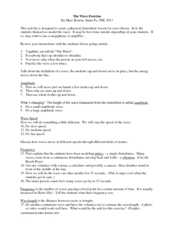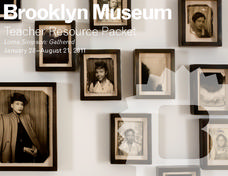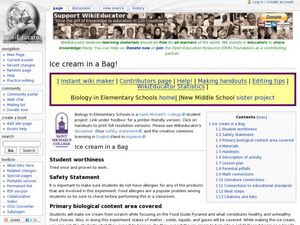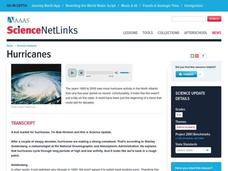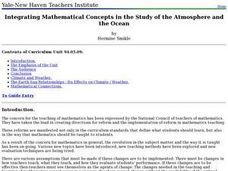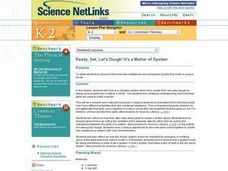Curated OER
Energy At Play
If you can find Tinker Toys™, then this may be a fun assignment for your physical science class. Using the construction set and a few other toys, they examine the forces involved when it they are being played with. For each, they...
Curated OER
Those Fabulous Fables
A video leads off this activity on fables, introducing the class to this important form of traditional storytelling. The group defines fable and hears an explanation of the origin of this type of folk tale. They summarize the story they...
Curated OER
Water Cycle Reading and Writing
Here is a great way to get pupils to express a scientific concept in a fun way. After hearing the story of Walter the Water drop and learning facts about the water cycle, the class will write a creative expository piece describing what...
Curated OER
Cartoons for the Classroom: Great Expectations
Learners can use this worksheet to discuss the expectations placed on the Obama presidency. Included are two cartoons to analyze, a web site to visit, several great discussion questions, and a short activity. This is one worksheet that...
The Science Spot
The Wave Exercise
During a lesson on wave motion, physical science participants basically act out the waves as a group. Through their movements, the amplitude, speed, frequency, and wavelength are all identified. Ideas for modeling the reflection and...
Curated OER
Choose the Homograph
Practice homographs with this fun worksheet! Learners choose the meanings of ten homographs based on the sentence's context clues. The worksheet has a picture of bats - one flying mammal, and one used in baseball. Use this resource as a...
Consortium for Ocean Science Exploration and Engagement (COSEE)
Understanding the Food Web
Building on prior knowledge of the pervious lesson in the series, pupils explain the previous lesson to each other. Then they write a simple guide for a young child to read on the same topic.
Science Matters
Landforms from Volcanoes
Three major types of volcanoes exist: cinder cone, composite/strata, and shield. The 18th lesson in a 20-part series covers the various landforms created from volcanoes. Scholars work in pairs to correctly identify the three types based...
Brooklyn Museum
Lorna Simpson: Gathered
Lorna Simpson is a photographer who has put together a collection of photos from the 1950s in order to challenge the idea that primary source documents are objective in their portrayal of history. Learners are introduced to Ms. Simpson's...
Virginia Department of Education
Predicting Products and Writing Equations
A chemistry lesson plan presents 14 chemical reactions for scholars to observe, write the equation, and balance the equations. Additionally, it provides ways to extend the activity as it relates to catalysts.
Curated OER
Indoor Air: What's the Matter?
Students develop a greater awareness of the variety and amount of particulate matter in the air. They try to locate general sources of pollution for a specific area and develop some suggestions for improving air quality.
Curated OER
The Air We Breathe
Students discover the cuases of pollution. They investigate different pollutants that exist. Stsudents research technologies developed by engineers to reduce the amounts of air pollution. Upon completion of assigned activities,...
Curated OER
Pieces of Mind: Remembering What Matters
Pupils watch the program "Pieces of Mind" from PBS and participate in a class discussion about PET scans and their advantages. Students then brainstorm activities a PET scan could be used for.
Curated OER
You Light Up My Life: Developing a Scientific Theory for What Fuels a Candle's Flame!
Young scholars examine how candles work and how scientific theories are developed and tested. Students propose hypotheses about what is burning in a candle then perform tests in order to develop their scientific theory. After a teacher...
Curated OER
Make it Rain!
Students describe how water exists on earth in three states. They trace the path that rain water follows after it falls. Students describe various forms that water takes on the earth's surface and conditions under which they exist....
Curated OER
Hurricanes
Students listen to a transcript of an interview about an upswing in hurricanes with Stanley Goldenberg, a researcher with the National Oceanographic and Atmospheric Administration. students participate in a series of discussion questions.
Curated OER
"If the facts don't fit the theory, change the facts"
Students read a paper describing Einstein's 1905 papers. They answer five teacher-provided questions in small groups to consider the importance of his findings. Students describe in personal writings what effect they think these findings...
Curated OER
Integrating Mathematical Concepts in the Study of the Atmosphere and the Ocean
Pupils utilize problem solving strategies that emphasis writing in mathematics, and strategies that have students make decisions and draw conclusions. They connect math to weather and climate topics.
Curated OER
Activity #19 The Density of Alka Seltzer Gas
Learners (teachers) complete the activity, they should not come in contact with Alka-Seltzer. They comprehend that the density of a gas can be calculated from its mass and volume. Pupils calculate the volume of gas generated by...
Curated OER
A Unique Circus
For this vocabulary worksheet, students chose the word that will best fit in the sentence from the word bank. Students will chose between, verbs and nouns to complete their worksheet.
Curated OER
Ethics In The Science Classroom - Fraud In Science
Students are given a fictitious case study to read in preparation for the class. This lesson can also be readily adapted for a role-playing classroom exercise. They discuss the ethical issues of the case.
Curated OER
Water and Ice
Students explore water and ice. In this 3 states of matter lesson, students work with a partner to observe, illustrate, and describe the characteristics of an ice cube in a cup. The ice cube is observed again in 15 minutes and changes...
Curated OER
Ready, Set, Let's Dough! It's A Matter Of System
Students discover that everyday substances are composed of parts that make a unique whole. Thsy examine a complex system when they create their own play dough by taking several parts and creating a whole.






